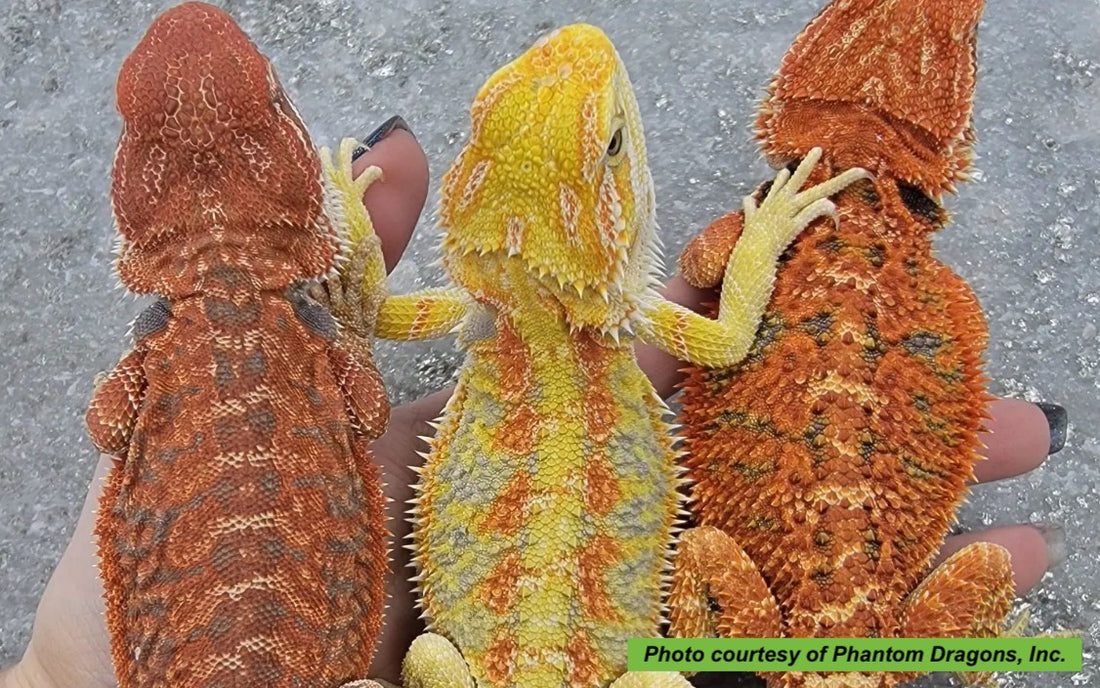Bearded dragons have been bred and kept as pets in the United States since the 1990s. Over the years, breeders have discovered 11 different morphs displaying various colors, patterns, and physical characteristics. Some look similar to the typical brown bearded dragon you’d find out in the wild, but some of them look pretty exotic.
Whether you’re new to bearded dragons or an experienced Dragon Keeper looking to expand your pet family, it’s helpful to know a little about each bearded dragon morph.
But it can be overwhelming to try to figure out where to start—so that's why we put together this beginner’s guide to bearded dragon morphs and colors. Once you dive in and start learning, you can always talk to a respected breeder for more detailed information.
What Is a Bearded Dragon Morph?
If you’re just starting to learn about the different colors and physical characteristics of bearded dragons, you’ll hear three words used quite often: morph, pattern, and color. It can be confusing unless you know what is meant by each word.
So, what is a bearded dragon morph, anyway?
“Morph” refers to the dragon’s physical characteristics—in other words, the look and size of the dragon. A morph can be physical (e.g. length), visual (e.g. pattern), or both. You may also hear morphs referred to as “scaling morphs,” which signifies a morph affecting the bearded dragon’s scales. Technically, this would fall under the category of a physical morph.
Bearded Dragon Color and Pattern
And what is meant by pattern and color (sometimes called “coloration”)?
“Pattern” is generally used to refer to three different visual or physical attributes of your dragon:
- It can refer to the design on the scales of a dragon—such as brown spots or tiger stripes.
- It can also refer to the direction the scales lie in—such as vertical vs. horizontal.
- It can also denote the direction of the spikes, which are distinct from scales.
“Color” or “coloration” refers to the overall hue or hues and saturation of a bearded dragon. Probably the most straightforward of our three definitions here!
Types of Bearded Dragon Patterns
There isn’t much of a standard for defining or describing bearded dragon patterns. As the Bearded Dragon Lady explains in her blog, “Breeders can call a color and pattern whatever they want, it is truly a matter of opinion, morph however is not.”
Even so, there are some common elements that occur on various bearded dragon morphs:
- Stripes, which typically run horizontally down the back, but on some morphs run vertically across
- Spots or blotches
- Spikes or scales pointing in different directions
- Spikes or scales pointing the same direction
Types of Bearded Dragon Morphs
There are two types of bearded dragon morph: scaling morphs and visual morphs. Scaling morphs affect the bearded dragon’s scales, whereas visual morphs affect color and pattern. A morph may be both scaling and visual.
Here are the 11 bearded dragon morphs:
1. Standard. Unsurprisingly, this is the most common bearded dragon morph. This is typically what you think of when you think of a bearded dragon—a yellow, brownish, or tan colored dragon with a triangle-shaped head, black nails, and rigid, rubbery scales that run horizontally across the dragon’s back.
2. German Giant. As the name suggests, a German Giant is a lot larger than a standard bearded dragon. This uncommon morph can grow up to 25-30 inches long.
3. Leatherback. The leatherback—aptly named for its leathery skin—has fewer, shorter spikes than a standard morph. Some have no spikes. And the scales are smaller than a standard bearded dragon's scales, which contributes to the smooth, leathery feeling of the skin. Their color and patterns tend to be vivid.
4. Dunner. The dunner morph has a distinct visual pattern and a distinct scaling pattern, making it both a visual and a scaling (physical) morph. The dunner usually has more scales than other morphs, and those scales point out in all directions rather than facing one way. The visual pattern, which runs down the back and tail, consists of spots made by scales of different colors.
5. Hypo (short for hypomelanistic). A hypo is characterized by a lack of pigment—not a total lack, but enough to make them noticeably light and pale in color. Hypos typically have clear nails, rather than black. They may have a visual pattern, but it will look faded.
6. Zero. A zero has no color and no pattern, so their name suits them. A zero can be a hypo zero or a non-hypo zero. According to 7th Galaxy Dragons, “Hypo zeros tend to be paper-white while non hypo zeros are more silver and gray.”
7. Witblits. This morph is pale and patternless. Witblits can be colored, though the color will look washed out or faded.
8. Wero. This morph is a combination between a visual zero and a witblit. Hence the name, “wero.” Unlike witblits, which can be colored, weros have no color.
9. Translucent. Also known as “Trans,” this morph is so named for an obvious reason: their scales and spikes look gummy and almost clear, or translucent. A translucent bearded dragon’s colors can often be seen quite vividly through their clear scales. As babies, they may have solid black eyes and blue eyelids.
10. Paradox. This is a very rare morph, and a beautiful one. The paradox exhibits blotches or speckles of color that can look like splattered paint. The color splotches may be bright or dull, symmetrical or asymmetrical.
11. Silkie. Named after their sleek and smooth skin, silkies have no scales. This is really unfortunate because bearded dragons need scales to protect themselves from harm in their day-to-day activities.
Are Silkie Bearded Dragons Unethical to Produce?
Silkback bearded dragons require special care and are prone to serious injury. A silkback is very easily injured by even mildly sharp objects. If they don’t have daily baths, they can lose parts of their tail or toes because their shed gets stuck.
The silkie morph diminishes a bearded dragon’s quality of life, plain and simple. Because of this, breeding silkies is widely considered to be unethical.
The breeders at Here B Dragons explain it succinctly:
“All reptiles have skin. A reptile's scales grow out of the top layer of their skin, similar to how hair grows out from the skin of mammals, and feathers grow out from the skin of birds. Their scales are protective and the skin beneath is not meant to be exposed. … The silkback condition should be considered a genetic defect because the condition hinders their ability to live a normal, healthy life.”
A Quick Look at Some Bearded Dragon Morphs
Reading about each morph isn't enough to give you a clear image of what they might look like. These photos, which were generously shared by bearded dragon breeders, should give you a good idea of the key characteristics you may see within various morphs.
—————
Below is a dunner morph. Even from the side, you can see the distinct visual pattern running down its back.

Photo courtesy of Keven Vogenberger at Reptile Mart.
—————
This one is a hypo leatherback dunner morph. The leathery scales give the pattern a more defined and almost flat appearance.

Photo courtesy of CEC Dragons.
—————
Here is a witblit morph. You can see that it does exhibit a beautiful orange color, although it is washed out or faded.

Photo courtesy of Phantom Dragons, Inc.
—————
Below on the left is a hypo trans wero (notice the lack of pigment and gummy scales) and on the right, a normal wero.

Photo courtesy of Phantom Dragons, Inc. on Instagram.
—————
Here is a hypo trans zero morph exhibiting a muted blueish-gray color. You can see the paleness caused by the lack of pigment in a hypo and the gummy look of the scales which is characteristic of a trans. There is no visual pattern, which is typical of a zero.

Photo courtesy of CEC Dragons.
—————
Here is a hypo paradox morph with an almost colorless tail and beautiful orange and blue splatters down its back.

Photo courtesy of CEC Dragons.
Bearded Dragon Colors
When you think of a bearded dragon typically you’re thinking of the Central Bearded Dragon, scientific name Pogona vitticeps, native to Australia.
According to the Australian Museum, you won’t find bright-colored bearded dragons scurrying around in the wild. You’ll find sandy-colored dragons that blend in with their environment:
“Unlike the Eastern Bearded Dragon which is mostly grey, the Central Bearded Dragon can also be found in a variety of colours, including shades of red, brown and yellow. These colours normally match the colour of soil that occurs in the dragon’s habitat.”
These are sometimes called “natural” bearded dragon colors—which makes sense, since they describe the dragon colors you’d find out in nature.
Common Bearded Dragon Colors
Not surprisingly, the most common bearded dragon colors are the “natural” ones:
- Brown and gray. This is by far the most common color you’ll see in bearded dragons, especially if you’re looking at a pet store.
- Yellow. This color is the most frequently produced by breeders. Depending on the hue, a yellow bearded dragon doesn’t always look much different than a brown one.
- Red. This color is perhaps the second most commonly bred, next to yellow. Red dragons can be quite striking.
- Orange. A dull orange might occur in the wild, whereas a fiery bright orange is the result of breeding.
Rare Bearded Dragon Colors & Patterns
Brighter versions of the above colors—such as fire engine red, lemon yellow, and light pink—are not “natural” and therefore less common. Depending on the morph, a dragon may exhibit these colors all over or in patterns or splotches.
One such pattern that occurs in a dragon with blue coloring is called Blue Bars. They may be bright or dark blue and will appear either in vertical bars or horizontal stripes.
In this photo, the dragon on the right exhibits blue bars.

Photo courtesy of Phantom Dragons, Inc. on Instagram.
Some other uncommon colors include blue, silver, and purple. Blue and purple dragons are the product of two translucent morphs. Many dragons that exhibit blue and purple coloring all over when they are young will lose the coloring as they grow, making blue and purple adult dragons very rare.
Albino Dragons & Leucism
There are two terms that can be confusing in regards to white or pale colored dragons. These are “albino” and “leucism.”
“Albino” is a term that means an animal produces no melanin. There is no such thing as an albino dragon. Well, technically there is, but they don’t tend to make it to adulthood. The breeders at Here B Dragons explain:
“Currently there are no albino bearded dragons. … There has not yet been a strain of albinism discovered that is viable for producing healthy, breedable bearded dragons.”
Some people think that an albino dragon refers to any white dragon. This isn’t true, since white dragons produce melanin. A telltale sign of a white dragon vs. an albino dragon would be the red eyes of an albino.
“Leucism” can sometimes be confused with albinism, because it refers to a reduction in melanin, which results in the animal being a lighter color or white. Certain morphs exhibit leucism—for example, hypos and zeros. But these dragons are not albino, since they produce some melanin.
Fake Bearded Dragon Morphs
Have you ever heard of a “pygmy dragon” or “fancy morph”? They aren’t real morphs. According to The Bearded Dragon Lady, these are just descriptive words used by breeders who either don’t know what morph they’re selling, or want to make the dragon sound extra valuable so they can charge more money. If you’re in the market for a bearded dragon, be wary of sellers who use phrases like this.
Do Bearded Dragon Colors, Morphs, and Patterns Change Over Time?
A morph will always be the same morph (a dunner can’t turn into a wero, for example), but color and patterns can change.
The change most often occurs as a young dragon grows. A distinct pattern may dissipate into a solid color. A bright color may fade. A pale color with a faded pattern may become more vibrant.
Unless you have a standard morph or a German Giant, it can be difficult to know what your dragon will look like when they’re fully grown.
Shopping for Bearded Dragon Morphs Online
If you’re searching for a specific bearded dragon morph, here is a word of advice. Never assume that a picture you see of a bearded dragon online is actually how they look in real life. Sometimes, breeders alter photos or make up long, descriptive names to make it seem like a dragon is unique or special. Knowing the actual distinct morphs vs subjective adjectives can help you shop smarter.
Additionally, be sure to do business with a trusted and ethical breeder. Do your research and make sure you know enough about the breeder to feel comfortable spending your hard-earned money on one of their dragons.
Sources & Further Reading:
https://mypetreptiles.com/bearded-dragon-colors-morph-and-patterns-with-pictures/
https://www.7thgalaxydragons.com/pages/bearded-dragon-morphs
http://www.beardeddragonlady.com/morph-color-pattern.html
https://www.thesprucepets.com/bearded-dragon-morphs-4173672
https://thepetenthusiast.com/common-bearded-dragon-morphs-and-colors/
https://www.herebdragons.com/bearded-dragon-mutations/
If you have questions or would like to give feedback, please email us at team@dragonsdiet.com








